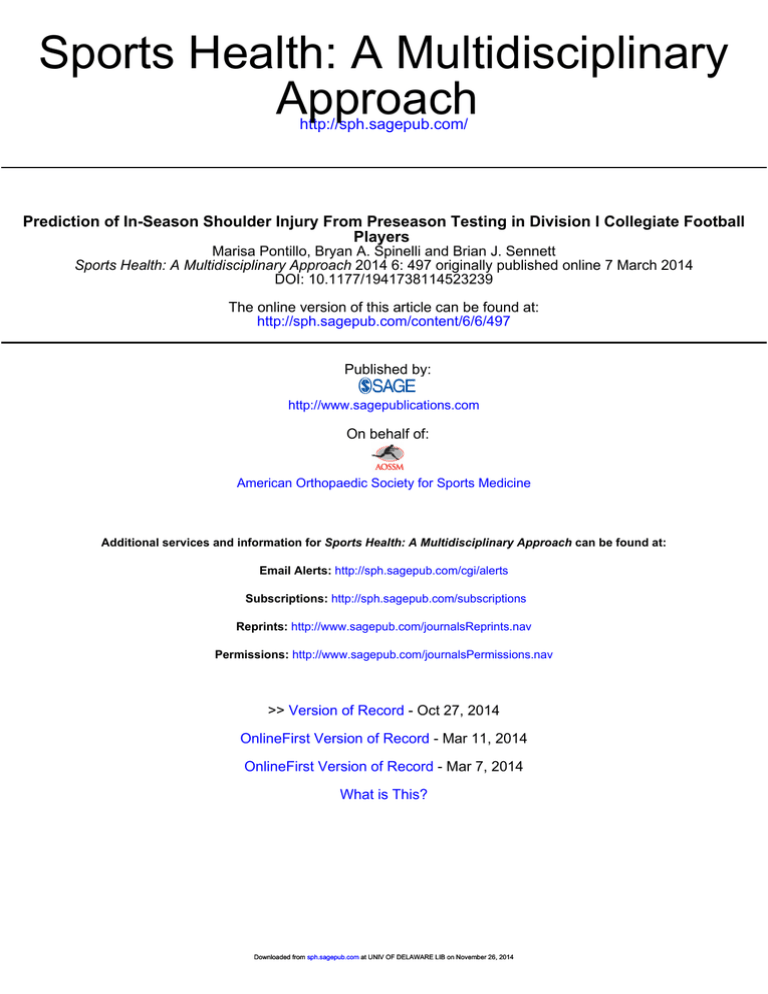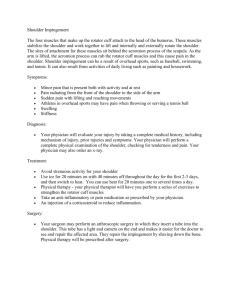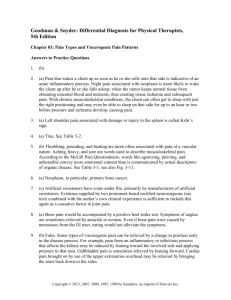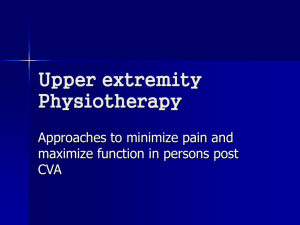Sports Health: A Multidisciplinary Approach
advertisement

Sports Health: A Multidisciplinary Approach http://sph.sagepub.com/ Prediction of In-Season Shoulder Injury From Preseason Testing in Division I Collegiate Football Players Marisa Pontillo, Bryan A. Spinelli and Brian J. Sennett Sports Health: A Multidisciplinary Approach 2014 6: 497 originally published online 7 March 2014 DOI: 10.1177/1941738114523239 The online version of this article can be found at: http://sph.sagepub.com/content/6/6/497 Published by: http://www.sagepublications.com On behalf of: American Orthopaedic Society for Sports Medicine Additional services and information for Sports Health: A Multidisciplinary Approach can be found at: Email Alerts: http://sph.sagepub.com/cgi/alerts Subscriptions: http://sph.sagepub.com/subscriptions Reprints: http://www.sagepub.com/journalsReprints.nav Permissions: http://www.sagepub.com/journalsPermissions.nav >> Version of Record - Oct 27, 2014 OnlineFirst Version of Record - Mar 11, 2014 OnlineFirst Version of Record - Mar 7, 2014 What is This? Downloaded from sph.sagepub.com at UNIV OF DELAWARE LIB on November 26, 2014 523239 research-article2014 SPHXXX10.1177/1941738114523239Sports HealthPontillo et al. vol. 6 • no. 6 SPORTS HEALTH [ Athletic Training ] Prediction of In-Season Shoulder Injury From Preseason Testing in Division I Collegiate Football Players Marisa Pontillo, PT, DPT, SCS,*† Bryan A. Spinelli, PT, MS, OCS, CLT-LANA,† and Brian J. Sennett, MD‡ Background: Collegiate football is a high-demand sport in which shoulder injuries are common. Research has described the incidence of these injuries, with little focus on causative factors or injury prevention. Hypothesis: Football athletes who score lower on preseason strength and functional testing are more likely to sustain an in-season shoulder injury. Study Design: Prospective, cohort study. Level of Evidence: Level 2. Methods: Twenty-six collegiate football players underwent preseason testing with a rotational profile for shoulder range of motion, isometric strength of the rotator cuff at 90° elevation and external rotation in the 90/90 position, fatigue testing (prone-Y, scaption, and standing cable press), and the Closed Kinetic Chain Upper Extremity Stability Test (CKCUEST). Data collected postseason included the type of shoulder injury and the side injured. Logistic regression was used to determine if the testing measures predicted injury, and a receiver operating characteristic curve was constructed to examine the relationship of CKCUEST to injury. Results: Six athletes sustained shoulder injuries during the season. Predictor variables could significantly predict whether that player would sustain an injury during the season for both the right and left shoulders (P < 0.05). The variables that were significantly correlated with injury of the right side were forward elevation strength, prone-Y to fatigue, and the CKCUEST (P < 0.05); on the left, only the CKCUEST was significant (P < 0.05). The area under the receiver operating characteristic curve for the CKCUEST was 0.86 (ε = 0.87, P = 0.01). Using a score of 21 touches, the CKCUEST had a sensitivity of 0.83, a specificity of 0.79, and an odds ratio of 18.75 in determining whether a player sustained a shoulder injury. Conclusion: For this sample, the combination of preseason strength, fatigue, and functional testing was able to identify football players who would sustain a shoulder injury during the season. Clinical Relevance: Using a battery of strength, fatigue, and functional testing may be helpful in identifying football players during preseason who are at a higher risk for sustaining a shoulder injury. This information can be used to optimize preseason testing and implementation of injury prevention programs. Keywords: football; injury prediction; shoulder From †GSPP Penn Therapy and Fitness at Penn Sports Medicine Center, Philadelphia, Pennsylvania, and ‡Department of Orthopaedic Surgery, University of Pennsylvania Health System, Philadelphia, Pennsylvania *Address correspondence to Marisa Pontillo, PT, DPT, SCS, Sports Team Leader, GSPP Penn Therapy and Fitness at Penn Sports Medicine Center, 235 South 33rd Street, Suite 1, Philadelphia, PA 19104 (e-mail: marisa.pontillo@uphs.upenn.edu). The authors report no potential conflicts of interest in the development and publication of this article. DOI: 10.1177/1941738114523239 © 2014 The Author(s) Downloaded from sph.sagepub.com at UNIV OF DELAWARE LIB on November 26, 2014 497 Pontillo et al Nov • Dec 2014 A merican football is a high-demand sport in which upper extremity injuries are often sustained, accounting for approximately 20% of injuries at the National Collegiate Athletic Association (NCAA) level.3 These injuries can occur via contact (player, ball, blocking dummies, or ground) or noncontact mechanisms.10 Acromioclavicular joint separations are the most common, but sternoclavicular joint separations, contusions, anterior or posterior dislocations, and pectoralis major injuries also occur.11 Additionally, upper extremity injuries can be sustained through repetitive microtrauma with throwing, blocking, and strength and conditioning workouts.10 Although protective equipment is designed to absorb forces and reduce injury, tackling still results in tremendous impact forces in the shoulder girdle, recorded as high as 1684 N.17 Unfortunately, the literature to date focuses on incidence and prevalence3,9 and equates injury prevention to protective equipment rather than biomechanical factors. Despite the prevalence of these injuries, prevention programs are rarely in place. Currently, injury prevention programs are predominantly expert opinion15; data-driven programs do not exist, nor has any program been shown to be effective in injury reduction for the shoulder. Preseason shoulder strength can identify baseball athletes who are at risk for injury.1 Comprehensive yet specific injury prevention strategies may maximize a player’s health status via injury reduction and improve fiscal responsibility through a reduction in time lost from competition and health care costs. The first step to injury prevention is identifying athletes who are at higher risk for sustaining an injury. Strength, fatigue, and functional testing should all be investigated to potentially identify athletes who are at a higher risk of sustaining an upper extremity injury. Functional testing for the upper extremity provides objective information about activities during sport. Several tests have been developed; the most widely utilized is the Closed Kinetic Chain Upper Extremity Stability Test (CKCUEST).8 This test has high test-retest reliability, with an intraclass correlation coefficient of 0.922,6 and correlates to rotator cuff strength measured using a handheld dynamometer (both elevation and internal rotation).13 This test can be used to benchmark athletes as well as to determine return to play status. The advantage of functional testing is to obtain valuable information on how the athlete uses an upper extremity during a task by utilizing several constructs simultaneously (strength, speed, and stabilization). We hypothesized that strength, fatigue, and functional testing performed prior to the season will identify football athletes who are at higher risk of sustaining a shoulder injury in-season. Methods Twenty-six collegiate varsity football players (mean age, 19.6 years; range, 18-22 years; mean body mass index, 28.8 kg/m2; 15 offensive and 11 defensive players; 23 right-hand dominant) were examined prior to their fall season. They were recruited through the coaching staff on a volunteer basis. The inclusion 498 criterion was football athletes who currently played at the varsity level at a Division I university. Exclusion criteria included a current upper extremity or cervical spine injury. If a subject had a previous upper extremity or cervical spine injury but had been cleared by their physician for unrestricted participation, he was not excluded from the study. At the testing session, the following demographic and morphologic data were collected: height in centimeters, weight in kilograms, handedness, player position, and previous upper extremity or cervical spine injuries. The preseason testing session consisted of an outcome score (Penn Shoulder Score), a profile for shoulder range of motion at 90° of abduction, isometric strength by handheld dynamometer for external rotation (ER) at 90° and forward elevation (FE) in the full can position, fatigue testing in 3 positions (scaption, prone-Y, and standing cable press), and the CKCUEST. Fatigue testing consisted of scaption, standing cable press, and prone-Y utilizing a percentage of body weight as resistance (5%, 30%, and 3%, respectively) and measuring repetitions to fatigue. Data collected postseason included which athletes sustained shoulder injuries, side injured, and type of injury. Procedures Outcome Score The players completed the Penn Shoulder Score to ensure a high level of self-reported upper extremity function. The Penn Shoulder Score has established reliability and validity12 and consists of 3 subsections: pain (30 points), satisfaction (10 points), and function (60 points). Shoulder Screen The players’ weights were used to calculate the resistance utilized for the fatigue testing. If the calculated resistance fell between 2 levels, the higher was used. Examination The testing procedure was refined to include the minimum number of tests to respect the time constraints of the players who were in preseason camp yet was comprehensive. Range of motion was determined supine on a plinth (examination table) with the arm abducted 90° and horizontally adducted to 30°. Isometric Strength Isometric strength was assessed on a handheld dynamometer (Microfet 2; Hogan Health, Salt Lake City, Utah).4 Isometric strength testing was performed in 2 positions: full can position and external rotation at 90° of abduction. Two trials for each position were collected, with a 30-second rest between trials with the dynamometer strapped securely to an immovable object (Smith press; see Figure 1). Elevation was evaluated with the arm was in 90° FE in the plane of the scapula and neutral internal/external rotation (Figure 1); players resisted this position for 5 seconds. For external rotation, the player resisted external rotation maximally for 5 seconds in 90° of abduction Downloaded from sph.sagepub.com at UNIV OF DELAWARE LIB on November 26, 2014 vol. 6 • no. 6 SPORTS HEALTH Figure 1. Isometric strength testing for forward elevation. and 90° of external rotation (Figure 2). The dynamometer was secured to an immovable object so that tester strength would not affect the measurement. Fatigue Testing Fatigue testing was assessed in 3 positions. The prone-Y test was used to assess the endurance of the middle and lower trapezius muscles.6 The scaption test was used to assess the endurance of the rotator cuff and scapular stabilizers, since supraspinatus, infraspinatus, and serratus anterior (as well as deltoid) are all highly active during this motion.6 The standing cable press elicits high levels of muscle activity in the pectoralis major, latissimus dorsi, and anterior deltoid muscles.16 Although each exercise was performed to fatigue, overall fatigue levels were monitored by use of the Borg scale, and adequate rest between activities was ensured. Fatigue testing resistance was determined by pilot testing several healthy, uninjured football athletes not participating in the study. The resistance used for practice trials was less than that used for the fatigue trials to avoid premature fatiguing. Each test was performed once per subject per side to minimize any one portion of the test affecting subsequent portions of the test. Testing to fatigue was performed in time to a metronome. Task failure was defined as (1) unable to keep up with metronome, (2) demonstration of compensatory strategies, and (3) inability to achieve the operationally defined testing positions as stated (<90° of elevation for standing cable press and scaption, below parallel to floor for prone-Y).5 All tests were performed unilaterally. Figure 2. Isometric strength testing for external rotation. Standing Cable Press. While holding a cable pulley handle, the subject was instructed to perform a smooth, controlled pressing action (Figure 3a). The terminal arm position was 90° of flexion, neutral horizontal abduction/adduction, and full pronation (Figure 3b). They performed 5 practice reps at 20% body weight (BW) and then repetitions until failure at 30% BW. The test was terminated when they could not raise the arm to 90° or could not perform a repetition in time to the metronome. Scaption. There was a 3-minute rest break before scaption testing; timing started after completion of testing the first arm. To ensure complete fatigue, the Borg scale2 was assessed before and after the standing cable press (Figure 4a). They performed several (2-3) repetitions without weight to ensure correct motion (“full can” position; Figure 4b); testing was performed with 5% BW. Prone-Y. The players performed several (2-3) repetitions without weight to ensure correct form; testing was performed at 3% BW (Figure 5). Closed Kinetic Chain Upper Extremity Stability Test When the test starts, one hand is brought over to the opposite tape line, returns, and repeats with the opposite hand (Figure 6). The goal is the highest number of touches that can be achieved in 15 seconds. Two trials were performed, with a 1-minute break between trials. Downloaded from sph.sagepub.com at UNIV OF DELAWARE LIB on November 26, 2014 499 Pontillo et al Nov • Dec 2014 Figure 3. Standing cable press. (a) Start position; (b) end position. Figure 4. Scaption test. (a) Start position; (b) end position. Statistical Analysis PASW Statistics 18 (IBM, Armonk, New York) was used for statistical analysis. Data were divided into left and right shoulders. Multiple logistic regressions were conducted to assess whether the predictor variables (strength, range of motion, fatigue, and functional testing) significantly predict 500 whether an athlete would sustain a shoulder injury the following season. Receiver operator characteristic (ROC) curve analysis was used to determine cutoff scores for the variables that significantly predicted sustaining an in-season shoulder injury. Sensitivity, specificity, positive and negative likelihood ratios, and odds ratio with 95% confidence intervals were calculated based on the cutoff scores by contingency tables. Downloaded from sph.sagepub.com at UNIV OF DELAWARE LIB on November 26, 2014 vol. 6 • no. 6 SPORTS HEALTH Figure 5. Prone-Y test. (a) Start position; (b) end position. Figure 6. Closed Kinetic Chain Upper Extremity Stability Test (CKCUEST). (a) Start position; (b) in progress. Results Mean test scores are reported in Table 1. Three athletes each sustained left and right shoulder injuries during the season: recurrent anterior instability, recurrent anterior instability with Bankart tear, recurrent posterior instability with posterior labral tear (n = 2), rotator cuff tendinopathy, and acromioclavicular joint separation. Only the acromioclavicular joint separation was Downloaded from sph.sagepub.com at UNIV OF DELAWARE LIB on November 26, 2014 501 Pontillo et al Nov • Dec 2014 Table 1. Mean test scores (standard deviation) Test Score, Mean (Standard Deviation) Penn Shoulder Score 92.9 (6.3) CKCUEST (touches) 22.5 (4.3) Left Right PROM (deg) ER 85.6 (11.7) 87.0 (13.0) IR 51.5 (8.4) 51.5 (8.8) Isometric strength (N) ER 108.5 (20.5) 113.4 (19.6) FE 161.7 (28.0) 137.9 (30.7) Standing cable press (repetitions) 33.5 (10.7) 35.6 (10.1) Scaption (repetitions) 22.6 (4.5) 23.6 (5.6) Prone-Y (repetitions) 27.4 (7.0) 26.6 (6.2) CKCUEST, Closed Kinetic Chain Upper Extremity Stability Test; PROM, profile for shoulder range of motion; ER, external rotation; IR, internal rotation; FE, forward elevation. traumatic; all other injuries were caused by repetitive trauma. One injury was a recurrence of a previous injury. When all predictor variables were considered together, they predicted whether an athlete sustained a left shoulder injury (Borg2 = 18.36, df = 8, n = 25, P = 0.02) or a right shoulder injury (Borg2 =18.36, df = 8, n = 25, P = 0.03). The variables that correlated with right shoulder injury were FE strength (P = 0.05), prone-Y to fatigue (P = 0.05), and the CKCUEST (P = 0.05); for the left shoulder, only the CKCUEST was significant (P = 0.03). The CKCUEST scores for athletes injured during the season were all less than the mean score of 22.5 touches. Five of 6 athletes scored 20 or fewer touches. For the prone-Y test, 5 of 6 players who later sustained an injury scored lower than the average number of repetitions to failure, with 3 players scoring 20 or less repetitions. For the scaption to fatigue test, 5 of 6 players who went on to sustain an injury scored below the average number of repetitions to fatigue, with 4 players scoring 20 repetitions or less. Receiver operating characteristic curve analysis revealed an area under the curve equal to 0.75 (P = 0.05; 95% confidence interval [CI] = 0.58-0.92) for FE strength and 0.70 (P = 0.11; 95% CI = 0.46-0.94) for prone-Y to fatigue. Receiver operating characteristic curve analysis for the CKCUEST revealed an area under the curve equal to 0.86 (P < 0.01; 95% CI = 0.72-1.0), suggesting the ability to discriminate between those who sustained a shoulder injury and those who did not. A cutoff 502 Table 2. Sensitivity, Specificity, LRs, and ORs for the Closed Kinetic Chain Upper Extremity Stability Test (CKCUEST) Value (95% Confidence Interval) Sensitivity 0.79 (0.57-0.91) Specificity 0.83 (0.44-0.97) Positive likelihood ratio 4.74 (0.78-28.78) Negative likelihood ratio 0.25 (0.10-0.65) Diagnostic odds ratio 18.75 (1.68-209.55) score of <21.0 touches maximized both sensitivity and specificity (Table 2). Discussion In this study, athletes who scored lower on strength, fatigue, and/or functional testing were at increased risk for sustaining an in-season shoulder injury. This supported our hypothesis that various preseason tests would identify individuals who were at increased risk for sustaining an in-season shoulder injury. The advantage of using a multitude of tests was that we were able to Downloaded from sph.sagepub.com at UNIV OF DELAWARE LIB on November 26, 2014 vol. 6 • no. 6 SPORTS HEALTH simultaneously test multiple constructs in 1 session (namely strength, endurance, and function). Additionally, the protocol was selected by identifying tests that account for the major muscular stabilizers around the shoulder girdle, including the rotator cuff and scapulothoracic musculature. The battery of tests allowed us to assess supraspinatus, infraspinatus, middle and lower trapezius, serratus anterior, deltoid, pectoralis major, and latissimus dorsi muscles.7,16 We chose to perform 1 trial of each test as to not allow fatigue from 1 test to affect subsequent portions of the test. Furthermore, the Borg scale was used as a secondary analysis to ensure the subjects were sufficiently fatigued after each task (ie, each task at least “somewhat difficult”). The results suggest that FE strength and prone-Y to fatigue scores were not able to significantly discriminate between those who sustained a shoulder injury and those who did not. The CKCUEST was utilized as our functional test for a multitude of reasons. It is quick and easy to administer in the clinic and it tests in a closed kinetic chain position, which transfers to the demands of a football athlete’s shoulder. When the test was developed, normative values were reported for men, with a score of 18.5 touches, and women, with score of 20.5 touches.8 Normative values have been established specifically for collegiate athletes,14 and these scores may add value to physical assessment procedures. The CKCUEST appeared to be the most telling in terms of injury prediction for this population. Players who scored less than the cutoff of 21 touches were more likely to be injured, demonstrating a high sensitivity and specificity. Additionally, the odds ratio was 18.75, indicating that the subjects who scored less than the cutoff were more than 18 times more likely to sustain a shoulder injury. This test may be the most important because it assesses both muscle capacity and neuromuscular control of the upper extremity, simultaneously assessing stability, speed, endurance, and strength. Furthermore, it places the players in a closed kinetic chain position, which mimics the upper extremity position commonly used in football. The ability to concurrently assess multiple constructs is likely why this test is the most valuable. This study has several limitations. First, secondary to availability, only a small cohort was obtained, which limits its generalizability. Second, selection bias is possible since recruitment was on a volunteer basis. However, we broadened our criteria by including athletes who played all positions and included those who had and had not had a previous shoulder injury. Based on these preliminary results, we advocate the use of preseason testing to identify individuals who are at a higher risk of sustaining shoulder injury. The demands on the athletic shoulder are complex; football athletes, in particular, must work both in open and closed kinetic chain and sustain both large magnitude forces with contact and repetitive, smaller forces with noncontact activities. Thus, injury prevention programs should include training of both the rotator cuff and scapular musculature, in a variety of positions, to prepare football athletes for the forces that they will experience during practice, play, and strength and conditioning workouts. Acknowledgment The author thanks J. Gabe Horneff III, MD, who assisted in data collection. References 1. Byram IR, Bushnell BD, Dugger K, Charron K, Harrell FE Jr, Noonan TJ. Preseason shoulder strength measurements in professional baseball pitchers: identifying players at risk for injury. Am J Sports Med. 2010;38:1375-1382. 2. Borg G. Psychophysical bases of perceived exertion. Med Sci Sport Exer. 1982;14:377-381. 3. Dick R, Ferrara MS, Agel J, et al. Descriptive epidemiology of collegiate men’s football injuries: National Collegiate Athletic Association Injury Surveillance System, 1988-1989 through 2003-2004. J Athl Train. 2007;42:221-233. 4. Donatelli R, Ellenbecker TS, Ekedahl SR, Wilkes JS, Kocher K, Adam J. Assessment of shoulder strength in professional baseball players. J Orthop Sports Phys Ther. 2000;30:544-551. 5. Ebaugh DD, McClure PW, Karduna AR. Scapulothoracic and glenohumeral kinematics following an external rotation fatigue protocol. J Orthop Sports Phys Ther. 2006;36:557-571. 6. Ellenbecker TS, Manske R, Davies GJ. Closed kinetic chain testing techniques of the upper extremities. Orthop Phys Ther Clin North Am. 2000;9:219-229. 7. Escamilla RF, Yamashiro K, Paulos L, Andrews JA. Shoulder muscle activity and function in common shoulder rehabilitation exercises. Sports Med. 2009;39:663-685. 8. Goldbeck TG, Davies GJ. Test-retest reliability of the closed kinetic chain upper extremity stability test. J Sport Rehab. 2000;9:35-45. 9. Jobe F, Pink M. Classification and treatment of shoulder dysfunction in the overhead athlete. J Orthop Sports Phys Ther. 1993;18:427-430. 10. Kaplan LD, Flanigan DC, Norwig J, Jost P, Bradley J. Prevalence and variance of shoulder injuries in elite collegiate football players. Am J Sports Med. 2005;33:1142-1146. 11. Kelly BT, Barnes RP, Powell JW, Warren RF. Shoulder injuries to quarterbacks in the National Football League. Am J Sports Med. 2004;32:328-331. 12. Leggin BG, Michener LA, Shaffer MA, Brenneman SK, Iannotti JP, Williams GR Jr. The Penn Shoulder Score: reliability and validity. J Orthop Sports Phys Ther. 2006;36:138-151. 13. Pontillo M, Horneff JG, Huffman GR, Sennett BJ. The relationship between upper extremity strength, functional testing, and self-reported disability in collegiate athletes. J Orthop Sports Phys Ther. 2010;40:A108. 14. Pontillo M, Sennett BS. Profile of upper extremity rotator cuff strength and function in Division 1 collegiate athletes. J Orthop Sports Phys Ther. 2011;41:A45. 15. Reeser JC, Verhagen E, Briner W, Askeland TI, Bahr R. Strategies for the prevention of volleyball related injuries. Br J Sports Med. 2006;40:594-600. 16. Santana JC, Vera-Garcia FJ, McGill SM. Kinetic and electromyographic comparison of the standing cable press and bench press. J Strength Cond Res. 2007;21:1271-1279. 17. Usman J, McIntosh AS, Frechede B. An analysis of impact forces in an active shoulder tackle in rugby. Br J Sports Med. 2011;45:310-384. For reprints and permission queries, please visit SAGE’s Web site at http://www.sagepub.com/journalsPermissions.nav. Downloaded from sph.sagepub.com at UNIV OF DELAWARE LIB on November 26, 2014 503






